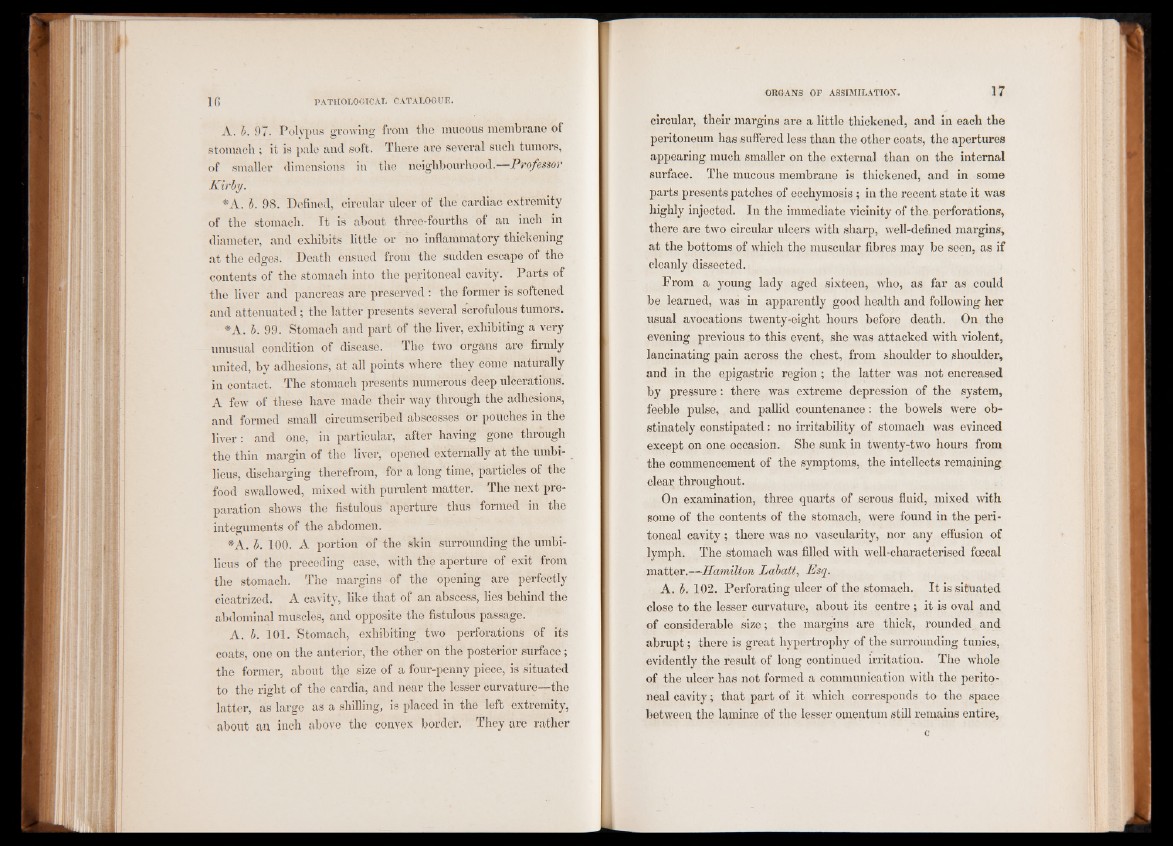
A. b. 97. Polypus growing from the mucous membrane of
stomach ; it is pale and soft. There are several such tumors,
of smaller dimensions in the neighbourhood.—Professor
Kirby.
*A. b. 98. Defined, circular ulcer of the cardiac extremity
of the stomach. It is about three-fourths of an inch in
diameter, and exhibits little or no inflammatory thickening
at the edges. Death ensued from the sudden escape of the
contents of the stomach into the peritoneal cavity. Parts of
the liver and pancreas are preserved : the former is softened
and attenuated; the latter presents several scrofulous tumors.
*A. b. 99. Stomach and part of the liver, exhibiting a very
unusual condition of disease. The two organs are firmly
united, ,by adhesions, at all points where they come naturally
in contact. The stomach presents numerous deep ulcerations.
A few of these have made their way through the adhesions,
and formed small circumscribed abscesses or pouches in the
liver: and one, in particular, after having gone through
the thin margin of the liver, opened externally at the umbi-
licus, discharging therefrom, for a long time, particles of the
food swallowed, mixed with purulent matter. The next preparation
shows the fistulous aperture thus formed in the
integuments of the abdomen.
*A. b. 100. A portion of the skin surrounding the umbilicus
of the preceding case, with the aperture of exit from
the stomach. The margins of the opening are perfectly
cicatrized. A cavity, like that of an abscess, lies behind the
abdominal muscles, and opposite the fistulous passage.
A. b. 101. Stomach, exhibiting two perforations of its
coats, one on the anterior, the other on the posterior surface ;
the former, about the size of a four-penny piece, is situated
to the right of the cardia, and near the lesser curvature—the
latter, as large as a shilling, is placed in the left extremity,
about an inch above the convex border. They are rather
circular, their margins are a little thickened, and in each the
peritoneum has suffered less than the other coats, the apertures
appearing much smaller on the external than on the internal
surface. The mucous membrane is thickened, and in some
parts presents patches of ecchymosis ; in the recent state it was
highly injected. In the immediate vicinity of the perforations,
there are two circular ulcers with sharp, well-defined margins,
at the bottoms of which the muscular fibres may be seen, as if
cleanly dissected.
From a young lady aged sixteen, who, as far as could
be learned, was in apparently good health and following her
usual avocations twenty-eight hours before death. On the
evening previous to this event, she was attacked with violent,
lancinating pain across the chest, from shoulder to shoulder,
and in the epigastric region ; the latter was not encreased
by pressure : there was extreme depression of the system,
feeble pulse, and pallid countenance : the bowels were obstinately
constipated : no irritability of stomach was evinced
except on one occasion. She sunk in twenty-two hours from
the commencement of the symptoms, the intellects remaining
clear throughout.
On examination, three quarts of serous fluid, mixed with
some of the contents of the stomach, were found in the peritoneal
cavity ; there was no vascularity, nor any effusion of
lymph. The stomach was filled with well-characterised foecal
matter.—Hamilton Labatt, Esq.
A. b. 102. Perforating ulcer of the stomach. It is situated
close to the lesser curvature, about its centre ; it is oval and
of considerable size; the margins are thick, rounded and
abrupt ; there is great hypertrophy of the surrounding tunics,
evidently the result of long continued irritation. The whole
of the ulcer has not formed a communication with the peritoneal
cavity ; that part of it which corresponds to the space
between the lamiiue of the lesser omentum still remains entire,
o